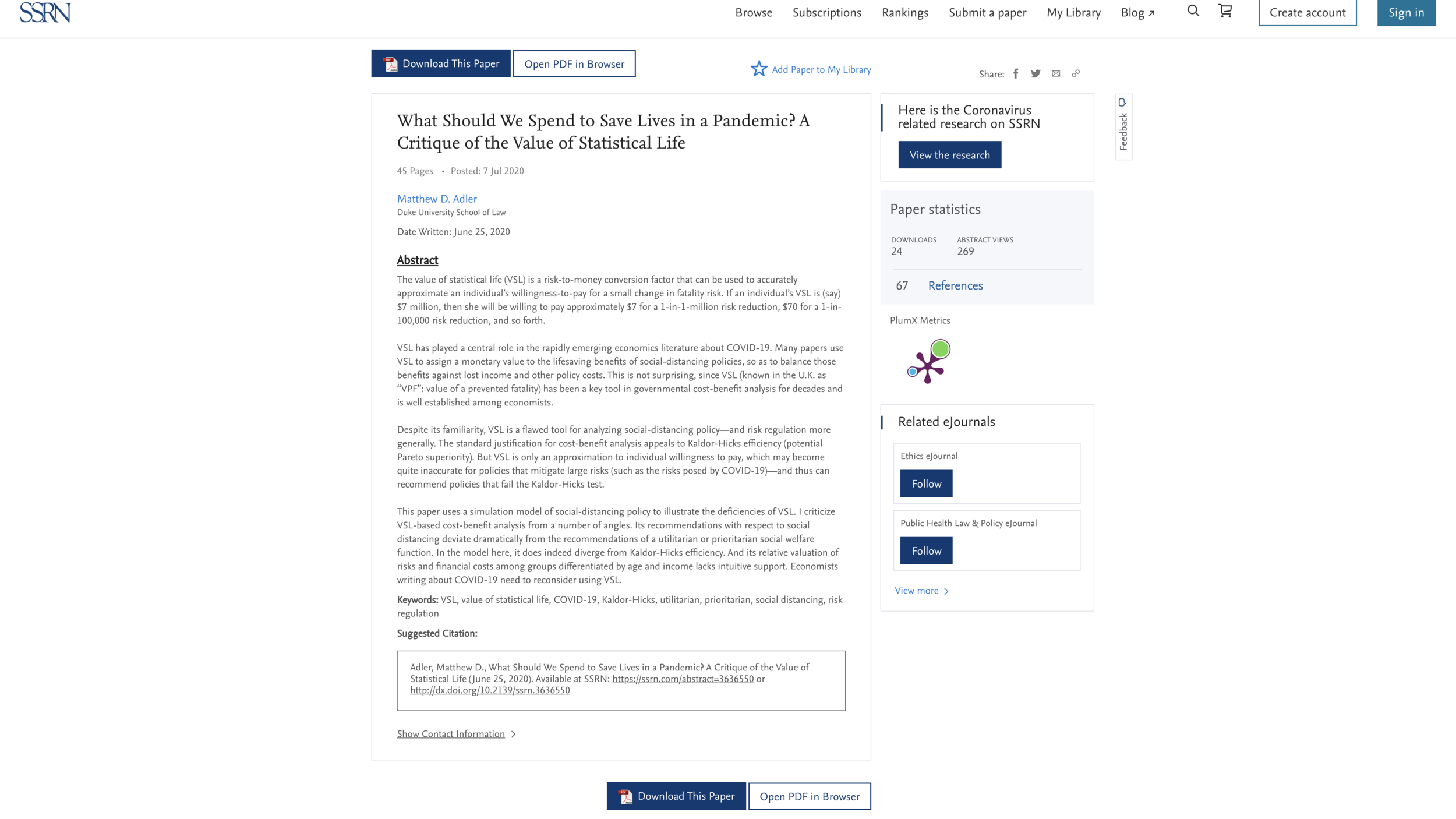Matt Adler's Critique of Methods Based on the Value of a Statistical Life
Matt Adler is a law professor economists should be aware of. He is doing serious work related to constructing social welfare functions. And he explains the current state-of-the-art for constructing social welfare functions in a very understandable way.
A Critique of Typical Value-of-a-Statistical-Life Methods
“What Should We Spend to Save Lives in a Pandemic? A Critique of the Value of Statistical Life” is a nice introduction to Matt Adler. Reading it, I realize, for example, the naivete in how I used the value of a statistical life in “Logarithms and Cost-Benefit Analysis Applied to the Coronavirus Pandemic.” The value of a statistical life is the marginal rate at which an individual would trade off a small extra probability of death with small dollar cost. There are at least three problems with common ways of using the value of a statistical life:
Some interventions are non-marginal. In particular, lockdowns can cause large reductions in income and consumption that are more-than-proportionately costly to an individual than smaller reductions in income and consumption would be. Hence, a naive application of the VSL formula will understate the utility cost of the lockdowns.
The value of a statistical life can easily differ by age—both because of the number of years that would be lost from death at that age and because of the different financial situations individuals have at different ages.
A good social welfare function should treat a dollar’s worth of value to someone living on $500 a month as being a bigger deal than a dollar’s worth of value to a billionaire.
Two notes: (a) The first two issues are problems even if one is treating a dollar as a dollar, regardless of whose dollar it is. (b) The different financial situations of older individuals mentioned in (2) are the kind of issue raised in (3).
On these three issues, it is worth quoting this passage from “What Should We Spend to Save Lives in a Pandemic? A Critique of the Value of Statistical Life”:
As for intuition: textbook VSL is quite counterintuitive, because it places a dramatically higher value on risk reductions for richer individuals; population-average VSL fails to differentiate with respect to age; and all three versions on the cost side are completely insensitive to the incidence of the costs of social distancing policy.
Prioritarianism
How should things be done if not through naive value-of-a-statistical-life methods? The current state-of-the-art for constructing social welfare functions can be described as “Prioritarianism.” Here is Matt Adler’s definition of Prioritarianism:
Prioritarianism is a variation on utilitarianism that has emerged in ethics over the last several decades, and (as suggested by the name) gives extra weight to the well-being of the worse off. It is appealing to those who are impressed by utilitarianism’s consequentialist structure and attention to individual well-being, but believe that utilitarianism’s exclusive focus on the sum total of well-being is too narrow. Instead, prioritarianism considers both the sum total and the distribution of well-being.
…
Prioritarianism sums expected transformed utilities, using a concave transformation function (so as to give greater weight to the worse off).
I am in agreement with Matt Adler on substance here, but I have a terminological disagreement, as follows:
To an economist, what Matt calls "transformed utility" is also "utility," since any monotonic transformation of utility is also a utility function that represents the same preferences. I think this needs to be explained, at least in a footnote.
Because transformed utility is also utility, Prioritarianism is not a variation on utilitarianism, but a type or species of utilitarianism in which the particular representation of utility is chosen not based on convenience of functional form or some empirical or metaphysical principle, but based on ethical reasoning to make sure that that particular transformation of utility used as the utility function adequately deals with distributional issues.
For example, logarithmic utility is primarily based on convenience and therefore typically has little behind it that should be taken seriously in forming a social welfare function. Convenience leads to wide use; then some people mistake prevalence as a hallowing by tradition that must have some basis back in the mists of time. But often the basis back in the mists of time was only convenience.
As a technical note, it is assumptions of anonymity plus a separability condition that make it so ethical considerations about inequality can be dealt with by using a particular transformation of utility as the intermediate object for aggregation. (Fleurbaey and Maniquet say this on separability: "separability conditions state that indifferent agents should not matter in the social evaluation of two alternatives.")
Conclusion
One of the most important things to be aware of is that welfare economics and the idea of constructing social welfare functions have risen again from the ashes like a phoenix after its reverses from the Arrow Impossibility Theorem and other impossibilities results. In particular, interpersonal comparison of a monotonic reference path of consumption bundles—together with a mapping for each individual of which indifference curve they are on to a point on that monotonic reference path—can substitute for interpersonal comparison of utility; thus interpersonal comparison of utility is not necessary for the construction of social welfare functions. Many economists and a few law professors and others are working hard on making theoretically sound social welfare analysis a reality. Our Well-Being Measurement Initiative (for which Dan Benjamin, Kristen Cooper, Ori Heffetz and I are the senior investigators) is marrying these principles to other principles specific to well-being measurement.
Don’t miss these other posts on the coronavirus pandemic:
Logarithms and Cost-Benefit Analysis Applied to the Coronavirus Pandemic
Seconding Paul Romer's Proposal of Universal, Frequent Testing as a Way Out
Also, click on this link to see other posts tagged “happiness.”
